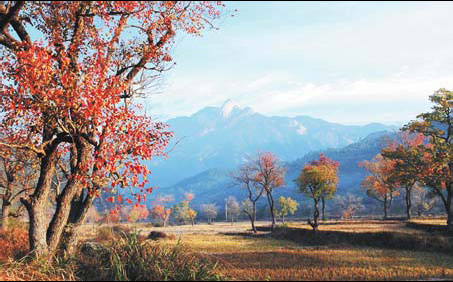Life and Leisure
City stitches together patchwork of tourist sites
By Guo Rui and Erik Nilsson (China Daily)
Updated: 2010-09-09 07:59
 |
Large Medium Small |
|
Colorful autumn foliage around Dabieshan, one of the biggest draws in Huanggang city. Hua Ren / for China Daily |
Pairs of shoes - one leather and one straw - hang above classroom doors in the high school of Huanggang city, which produces the country's top college entrance exam scorers, despite its poverty.
Teachers tell students the footwear represents two walks of life. The straw shoes typify an existence defined by deprivation, while the leather ones are filled by feet on a more comfortable journey through this world.
It's a lesson that's pertinent to students in Huanggang, where urban residents' average per capita income is 4,130 yuan ($608) and their rural neighbors' hovers around 1,300.
Consequently, it's a lesson well learned by Huanggang High School's students, 98 percent of whom enroll in university and 75 percent of whom go to the top schools.
But while outstanding education nurtures success, it has, somehow, failed to deliver general prosperity to the city of 7.3 million. That is where tourism will come in, Mayor Liu Xuerong says.
"Huanggang is an agricultural city without industry, so tourism is a good option for us," Liu says.
"But it is also a challenge."
The sector accounts for about 3 percent of the city's economy. About 5.5 million tourists visited Huanggang last year.
Liu believes it could take two or three decades for tourism to usurp farming's reign over the local economy.
But the necessary travel resources are there, Liu says.
Huanggang contains a vast swath of Dabieshan, a mountain range celebrated for its natural aesthetics and revolutionary legacy.
It is also home to what are believed to be the Red Cliffs of the famous battle that sustained the Three Kingdoms (AD 220-280) period's trisection.
And Huanggang has hosted a cast of historical figures, such as poets Su Dongpo (1037-1101) and Li Bai (AD 701-762), and moveable type printing press inventor Bi Sheng (990-1051).
But contriving a way to package the diverse litany of travel offerings is troublesome, Liu says, because no one attraction stands out as a marketing peg upon which the rest can be hung.
"Having so many travel resources is, paradoxically, an advantage and a disadvantage," Liu says.
"People's energies and memories are limited. They are better at remembering just one thing about one place so we are taking everything we have and putting it under a single name - Dabieshan. That has essentially become our brand."
That is because the mountain range encapsulates the revolutionary, ecological and cultural tourism resources that can propel Huanggang's development, he explains.
The government will clinch the alpine chain's identity as the city's "name card" with the Dabieshan Tourism Festival.
But while Huanggang has spun a common thread to conceptually stitch together its patchwork of tourism attractions with the Dabieshan brand, it has yet to physically connect the mountains' scattered scenic sites by roadway, Liu says.
A traffic route, slated for completion by year-end, will link seven cities and 22 counties that are home to 2.3 million people.
"Tourism development can't take place without this road," Liu says.
The next step, the mayor says, is establishing a government-supported tourism development corporation.
"Our tourism development requires money the local government just does not have, so we need to bring in a market player," he says.
This would allow financing that could accelerate the construction of infrastructure, he explains.
"The company would also link the different scenic areas into a unified chain of common interests," Liu says.
If Liu's plan works, it could generate enough revenue to choreograph a much better economic performance - maybe even the kind that can pay for a lot of leather shoes.
China Daily
